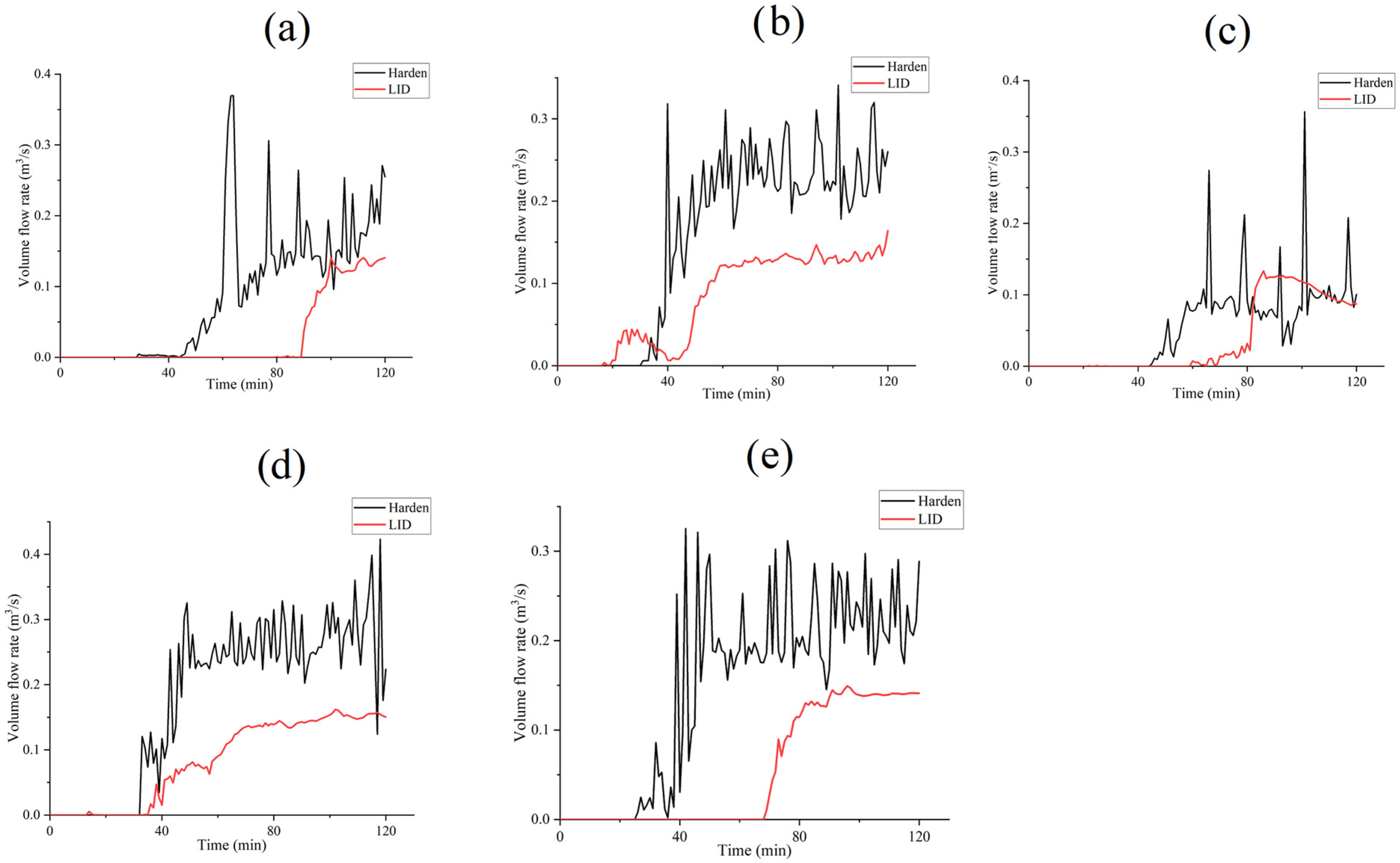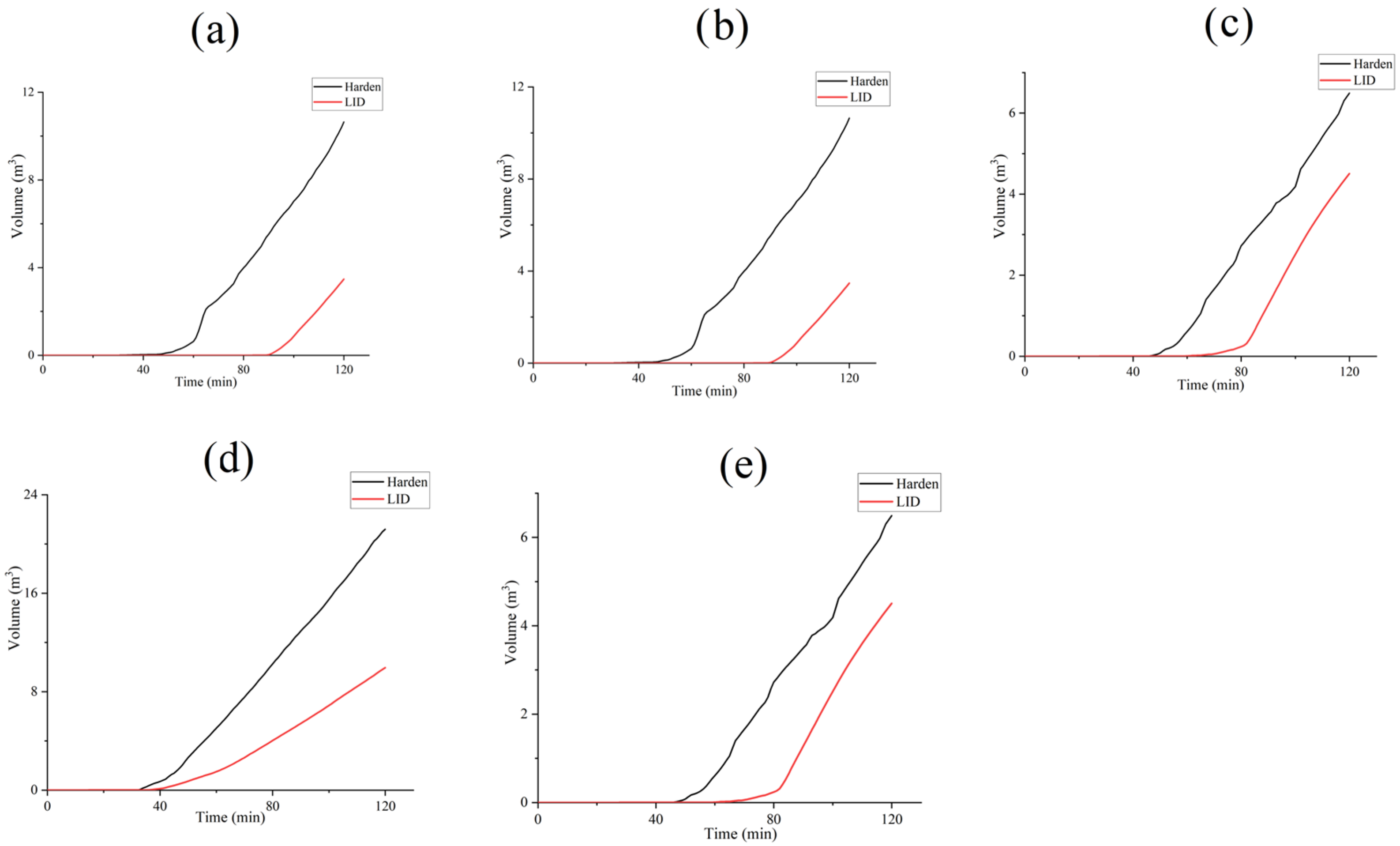Significance in Numerical Simulation and Optimization Method Based on Multi-Indicator Sensitivity Analysis for Low Impact Development Practice Strategy
Abstract
1. Introduction
2. Materials and Methods
2.1. Research Data Background
2.2. Design of Simulated Precipitation Events
2.3. Model Construction and Structural Parameter Setting
2.3.1. Computational Grid Construction
2.3.2. Physics Modeling and Boundary Conditions
2.4. Parameter Perturbation and Sensitivity Analysis
2.5. Formulas and Calculations
2.5.1. Design Storm Scenarios
2.5.2. Governing Equation of Fluid Motion
2.5.3. Viscous Turbulence Model
2.5.4. Morris Sensitivity Analysis
2.5.5. TOPSIS Optimal Solution Analysis Method
3. Results and Discussion
3.1. Simulation of Runoff Infiltration and Storage Process
3.2. Parameter Sensitivity Calculation and Effect Analysis
3.3. LID Performance Evaluation and Sorting Optimization Based on TOPSIS
3.4. LID Scenario Analysis and Benefit Evaluation
3.4.1. Simulation Effects of the LID Plans Under Different Structural Parameters
3.4.2. Simulation Effects of the LID Plans Under Different Rainfall Scenarios
4. Conclusions
- (1)
- The rainwater runoff control hydraulic process of the concave herbaceous field is mainly affected by its structural parameters and precipitation recurrence period. Morris sensitivity analysis and the TOPSIS method were used to analyze the sensitivity of the model parameters, and the results showed that factors b (planting soil thickness) and c (planting soil slope) had the most significant influence on the operation effect of the concave herbaceous field.
- (2)
- According to the TOPSIS optimal solution analysis results, the variation range of the optimal runoff control benefit corresponding to the dimension parameter of the concave green space is −10~10%. The optimal structural parameters were an aquifer height of 200 mm, a planting soil thickness of 600 mm, a planting soil slope of 1.5%, a planting soil porosity of 0.45, and an overflow pipeline porosity of 0.3.
- (3)
- Under the precipitation event with a recurrence period of 5a, the flood peak reduction rate, delay rate, and total runoff control rate were 88.93%, 51.11%, and 78.76%, respectively, and the optimal application condition of this optimal design scheme is the precipitation scenario where the return period is less than 10a.
Author Contributions
Funding
Institutional Review Board Statement
Informed Consent Statement
Data Availability Statement
Conflicts of Interest
References
- Wang, M.; Sweetapple, C.; Fu, G.; Farmani, R.; Butler, D. A framework to support decision making in the selection of sustainable drainage system design alternatives. J. Environ. Manag. 2017, 201, 145–152. [Google Scholar] [CrossRef] [PubMed]
- Matos, C.; Sá, A.B.; Bentes, I.; Pereira, S.; Bento, R. An approach to the implementation of Low Impact Development measures towards an EcoCampus classification. J. Environ. Manag. 2019, 232, 654–659. [Google Scholar] [CrossRef]
- Her, Y.; Jeong, J.; Arnold, J.; Gosselink, L.; Glick, R.; Jaber, F. A new framework for modeling decentralized low impact developments using Soil and Water Assessment Tool. Environ. Model. Softw. 2017, 96, 305–322. [Google Scholar] [CrossRef]
- Bicknell, B.R.; Imhoff, J.C.; Kittle, J.L., Jr.; Donigian, A.S., Jr.; Johanson, R.C. Hydrological Simulation Program-FORTRAN. User’s Manual for Release 11. 1996, US EPA. Available online: https://hydrologicmodels.tamu.edu/hspf-user-manual/tutorials-and-manuals/ (accessed on 10 November 2024).
- Rosa, D.J.; Clausen, J.C.; Dietz, M.E. Calibration and verification of SWMM for low impact development. JAWRA J. Am. Water Resour. Assoc. 2015, 51, 746–757. [Google Scholar] [CrossRef]
- US Environmental Protection Agency (USEPA). SUSTAIN-A Framework for Placement of Best Management Practices in Urban Watersheds to Protect Water Quality; Office of Water: Washington, DC, USA, 2009.
- Loperfido, J.V.; Noe, G.B.; Jarnagin, S.T.; Hogan, D.M. Effects of distributed and centralized stormwater best management practices and land cover on urban stream hydrology at the catchment scale. J. Hydrol. 2014, 519, 2584–2595. [Google Scholar] [CrossRef]
- Palla, A.; Gnecco, I. Hydrologic modeling of Low Impact Development systems at the urban catchment scale. J. Hydrol. 2015, 528, 361–368. [Google Scholar] [CrossRef]
- Liang, C.; Zhang, X.; Xu, J.; Pan, G.; Wang, Y. An integrated framework to select resilient and sustainable sponge city design schemes for robust decision making. Ecol. Indic. 2020, 119, 106810. [Google Scholar] [CrossRef]
- Arnold, J.G.; Srinivasan, R.; Muttiah, R.S.; Williams, J.R. Large area hydrologic modeling and assessment part I: Model development 1. JAWRA J. Am. Water Resour. Assoc. 1998, 34, 73–89. [Google Scholar] [CrossRef]
- Neitsch, S.L.; Arnold, J.G.; Kiniry, J.R.; Williams, J.R. Soil and Water Assessment Tool Theoretical Documentation Version 2009; Texas Water Resources Institute: College Station, TX, USA, 2011. [Google Scholar]
- Liang, Q.; Ren, X.-x.; Zhang, X. Cost-effectiveness Analysis of Low Impact Development Facilities Based on SUSTAIN Model. China Water Wastewater 2017, 33, 136–139. [Google Scholar] [CrossRef]
- Qiu, S.; Yin, H.; Deng, J.; Li, M. Cost-effectiveness analysis of green–gray stormwater control measures for non-point source pollution. Int. J. Environ. Res. Public Health 2020, 17, 998. [Google Scholar] [CrossRef]
- Hakimdavar, R.; Culligan, P.J.; Finazzi, M.; Barontini, S.; Ranzi, R. Scale dynamics of extensive green roofs: Quantifying the effect of drainage area and rainfall characteristics on observed and modeled green roof hydrologic performance. Ecol. Eng. 2014, 73, 494–508. [Google Scholar] [CrossRef]
- Feitosa, R.C.; Wilkinson, S. Modelling green roof stormwater response for different soil depths. Landsc. Urban Plan. 2016, 153, 170–179. [Google Scholar] [CrossRef]
- Baek, S.-S.; Ligaray, M.; Park, J.-P.; Shin, H.-S.; Kwon, Y.; Brascher, J.T.; Cho, K.H. Developing a hydrological simulation tool to design bioretention in a watershed. Environ. Model. Softw. 2019, 122, 104074. [Google Scholar] [CrossRef]
- Wang, Z. Sensitivity analysis of SWMM model LID facility parameters based on morris analysis. Water Wastewater Eng. 2019, 55, 57–62. [Google Scholar]
- Behzadian, M.; Otaghsara, S.K.; Yazdani, M.; Ignatius, J. A state-of the-art survey of TOPSIS applications. Expert Syst. Appl. 2012, 39, 13051–13069. [Google Scholar] [CrossRef]
- Luan, B.; Yin, R.; Xu, P.; Wang, X.; Yang, X.; Zhang, L.; Tang, X. Evaluating Green Stormwater Infrastructure strategies efficiencies in a rapidly urbanizing catchment using SWMM-based TOPSIS. J. Clean. Prod. 2019, 223, 680–691. [Google Scholar] [CrossRef]
- Wang, H.; Ding, L.; Cheng, X.; Li, N. Hydrologic control criteria framework in the United States and its referential significance to China. J. Hydraul. Eng. 2015, 46, 1261–1271. [Google Scholar] [CrossRef]
- Li, D.; Ju, Q.; Jiang, P.; Huang, P.; Xu, X.; Wang, Q.; Hao, Z.; Zhang, Y. Sensitivity analysis of hydrological model parameters based on improved Morris method with the double-Latin hypercube sampling. Hydrol. Res. 2023, 54, 220–232. [Google Scholar] [CrossRef]
- Tianjin Urban and Rural Construction Commission. Technical Guidelines for Sponge City Construction in Tianjin; Tianjin Construction Engineering Technology Research Institute: Tianjin, China, 2016. [Google Scholar]
- Launder, B.E.; Spalding, D.B. The numerical computation of turbulent flows. Comput. Methods Appl. Mech. Eng. 1974, 3, 269–289. [Google Scholar] [CrossRef]
- Fan, G.; Lin, R.; Wei, Z.; Xiao, Y.; Shangguan, H.; Song, Y. Effects of low impact development on the stormwater runoff and pollution control. Sci. Total Environ. 2022, 805, 150404. [Google Scholar] [CrossRef]
- Koc, K.; Ekmekcioğlu, Ö.; Özger, M. An integrated framework for the comprehensive evaluation of low impact development strategies. J. Environ. Manag. 2021, 294, 113023. [Google Scholar] [CrossRef] [PubMed]






| ID | A | B | C | D | E |
|---|---|---|---|---|---|
| Structure parameter name (unit) | Aquifer height (mm) | Planting soil thickness (mm) | Slope of planting soil (%) | Planting soil porosity (%) | Pipeline porosity (%) |
| Initial size | 200 | 600 | 1.5 | 45 | 30 |
| Value range | 100~300 | 250~1000 | 1~3 | 30~60 | >20 |
| Disturbance Ratio (%) | −30 | −20 | −10 | 0 (Initial) | 10 | 20 | 30 |
|---|---|---|---|---|---|---|---|
| Indicator | |||||||
| A | 140 | 160 | 180 | 200 | 220 | 240 | 260 |
| B | 450 | 480 | 540 | 600 | 660 | 720 | 780 |
| C | 1.05 | 1.20 | 1.35 | 1.50 | 1.65 | 1.80 | 1.95 |
| D | 31.50 | 36 | 40.50 | 45 | 49.50 | 54 | 58.50 |
| E | 21 | 24 | 27 | 30 | 33 | 36 | 39 |
| Indicator | Mean Value | Standard Deviation | Coefficient of Variation | Weight | Composite Coefficient |
|---|---|---|---|---|---|
| A | 0.644 | 0.194 | 30.18% | 6.47% | 0.2274 |
| B | 1.078 | 1.320 | 122.37% | 26.25% | 0.7536 |
| C | 0.700 | 0.839 | 119.94% | 25.73% | 0.4613 |
| D | 0.727 | 0.623 | 85.66% | 18.37% | 0.2008 |
| E | 0.366 | 0.396 | 108.06% | 23.18% | 0.0848 |
| Disturbance Ratio | Positive Ideal Solution Distance D+ | Negative Ideal Solution Distance D− | Relative Proximity C | Sort Result |
|---|---|---|---|---|
| −30% | 0.311 | 0.281 | 0.475 | 2 |
| −20% | 0.406 | 0.308 | 0.432 | 4 |
| −10% | 0.387 | 0.300 | 0.436 | 3 |
| 0% | 0.450 | 0.223 | 0.331 | 6 |
| 10% | 0.366 | 0.211 | 0.366 | 5 |
| 20% | 0.452 | 0.192 | 0.298 | 7 |
| 30% | 0.233 | 0.487 | 0.677 | 1 |
| Disturbance Ratio | Positive Ideal Solution Distance D+ | Negative Ideal Solution Distance D− | Relative Proximity C | Sort Result |
|---|---|---|---|---|
| −30% | 0.113 | 0.029 | 0.205 | 5 |
| −20% | 0.134 | 0.009 | 0.062 | 7 |
| −10% | 0.072 | 0.113 | 0.610 | 1 |
| 0% | 0.130 | 0.010 | 0.069 | 6 |
| 10% | 0.105 | 0.035 | 0.250 | 4 |
| 20% | 0.100 | 0.049 | 0.328 | 3 |
| 30% | 0.098 | 0.080 | 0.448 | 2 |
| Disturbance Ratio | Positive Ideal Solution Distance D+ | Negative Ideal Solution Distance D− | Relative Proximity C | Sort Result |
|---|---|---|---|---|
| −30% | 0.200 | 0.397 | 0.665 | 1 |
| −20% | 0.381 | 0.234 | 0.381 | 7 |
| −10% | 0.235 | 0.320 | 0.577 | 4 |
| 0% | 0.321 | 0.335 | 0.511 | 5 |
| 10% | 0.243 | 0.352 | 0.592 | 3 |
| 20% | 0.214 | 0.349 | 0.619 | 2 |
| 30% | 0.362 | 0.329 | 0.476 | 6 |
Disclaimer/Publisher’s Note: The statements, opinions and data contained in all publications are solely those of the individual author(s) and contributor(s) and not of MDPI and/or the editor(s). MDPI and/or the editor(s) disclaim responsibility for any injury to people or property resulting from any ideas, methods, instructions or products referred to in the content. |
© 2025 by the authors. Licensee MDPI, Basel, Switzerland. This article is an open access article distributed under the terms and conditions of the Creative Commons Attribution (CC BY) license (https://creativecommons.org/licenses/by/4.0/).
Share and Cite
Zhang, Q.; Zhang, M.; Jiang, W.; Sheng, Y.; Yuan, Y.; Zhang, M. Significance in Numerical Simulation and Optimization Method Based on Multi-Indicator Sensitivity Analysis for Low Impact Development Practice Strategy. Appl. Sci. 2025, 15, 4165. https://doi.org/10.3390/app15084165
Zhang Q, Zhang M, Jiang W, Sheng Y, Yuan Y, Zhang M. Significance in Numerical Simulation and Optimization Method Based on Multi-Indicator Sensitivity Analysis for Low Impact Development Practice Strategy. Applied Sciences. 2025; 15(8):4165. https://doi.org/10.3390/app15084165
Chicago/Turabian StyleZhang, Qian, Mucheng Zhang, Wanjun Jiang, Yizhi Sheng, Yingwei Yuan, and Meng Zhang. 2025. "Significance in Numerical Simulation and Optimization Method Based on Multi-Indicator Sensitivity Analysis for Low Impact Development Practice Strategy" Applied Sciences 15, no. 8: 4165. https://doi.org/10.3390/app15084165
APA StyleZhang, Q., Zhang, M., Jiang, W., Sheng, Y., Yuan, Y., & Zhang, M. (2025). Significance in Numerical Simulation and Optimization Method Based on Multi-Indicator Sensitivity Analysis for Low Impact Development Practice Strategy. Applied Sciences, 15(8), 4165. https://doi.org/10.3390/app15084165








